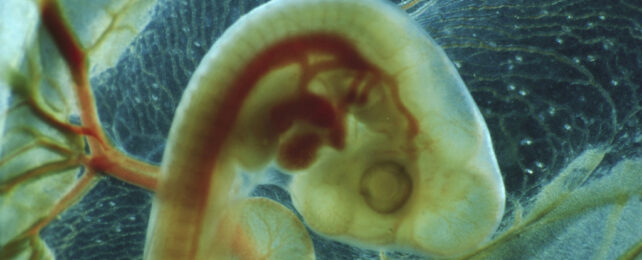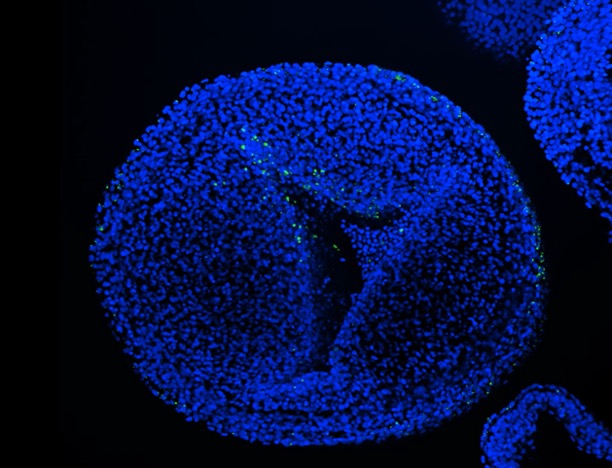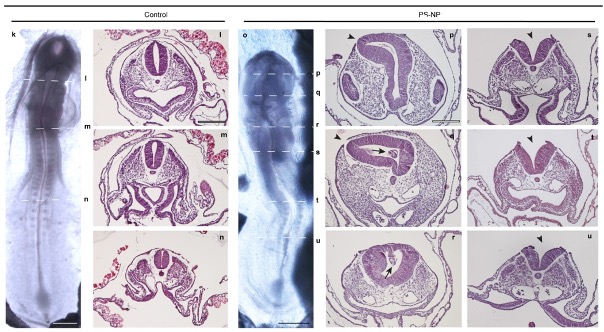Nanoplastics Interfere With Developing Chicken Embryos in Terrifying Ways
 Chicken embryo at 3.5 days. (Oxford Scientific/Getty Images)
Chicken embryo at 3.5 days. (Oxford Scientific/Getty Images)A new study of chicken embryos suggests that sufficient concentrations of teensy nanoplastics speckles could interfere with the earliest stages of development, glugging up stem cells from which tissues and organs usually emerge.
These tissue defects, the study authors say, are "far more serious and extensive than has been previously reported" and include heart defects, which have not been described before in animal studies of microplastics.
Under the focused gaze of fluorescent microscopes, biologist Meiru Wang of Leiden University in the Netherlands and colleagues watched injected samples of nanometer-scale glowing plastic particles cross the embryonic gut wall and circulate into multiple organs of the chick embryos.
"We used a high concentration of polystyrene particles, that would normally not be present in an organism. But it shows what nanoplastics can do in extreme cases on very young [chicken] embryos," Wang explains.
Nanoplastics are a fraction smaller than microplastics; both are typically produced when synthetic clothes shed plastic microfibers or larger plastics break down into ever smaller pieces under the glare of UV rays or mechanical weathering.
Past animal studies have tried to investigate the potential health risks of polystyrene microplastics, finding biochemical signs of potentially toxic effects as they accumulate in the livers, kidneys, and guts of laboratory mice.
While results like those only hint at what might be happening in humans, we have good reason to be concerned. Our dependency on cheaply made plastic goods and synthetic materials is polluting our oceans and air with microscopic shards of plastic polymers making their way into our bodies and out the other side.
Studies have found microplastics lodged deep in human lungs, circulating in our blood, and entering the placenta – the vital organ that shields unborn babies from pathogens and other potentially hazardous materials lurking in the mother's blood.
But the possible effects of microplastics on the early development of cells and tissues that go on to form organs and bodies are largely unknown. Most studies of that kind have been in aquatic organisms, such as zebrafish.
In these latest lab experiments, the polystyrene nanoplastics (25 nanometers in size) seemed to get stuck on stem cells called neural crest cells, stopping them from migrating into place where they would normally form important tissues and organs.
In all vertebrates, neural crest cells give rise to parts of the heart, arteries, facial structures, and nervous system.

A quarter of the chick embryos had one or two abnormally small eyes, while others showed facial deformities, thinning heart muscles, and slow heart rates.
Neural tube defects were also noted, which occur when the neural folds that form the early brain and spinal cord fail to meet and close properly. This all links back to those neural crest cells, the researchers suspect.
"Neural crest cells are sticky, so nano-particles can adhere to them and thereby disrupt organs that depend on these cells for their development," says Leiden University developmental biologist Michael Richardson.

Bear in mind the concentrations of nanoplastics used in this study were far above levels that humans have possibly been exposed to, and were injected in an artificial manner.
That said, the way nanoplastics appear to latch on to neural crest cells could be worrisome even in scenarios of low-level exposures, the researchers write. And they did find evidence that the defects became more widespread as nanoplastic concentrations increased.
More research is warranted, given the omnipresent threat microplastics pose in the environment. Studies like this one are only just beginning to sketch out the potential health impacts of 'plastic dust' on animals, as manufacturers churn out more of the stuff.
Nearly 360 million metric tonnes of plastic was produced in 2018, a number expected to double by 2025.
"These results are a matter of concern given the large and growing burden of nanoplastics in the environment," Wang and colleagues conclude.
"Even if society stops now with all plastic pollution, the weathered nanoplastic debris levels from existing plastics in the environment will still increase."
The research has been published in Environment International.
